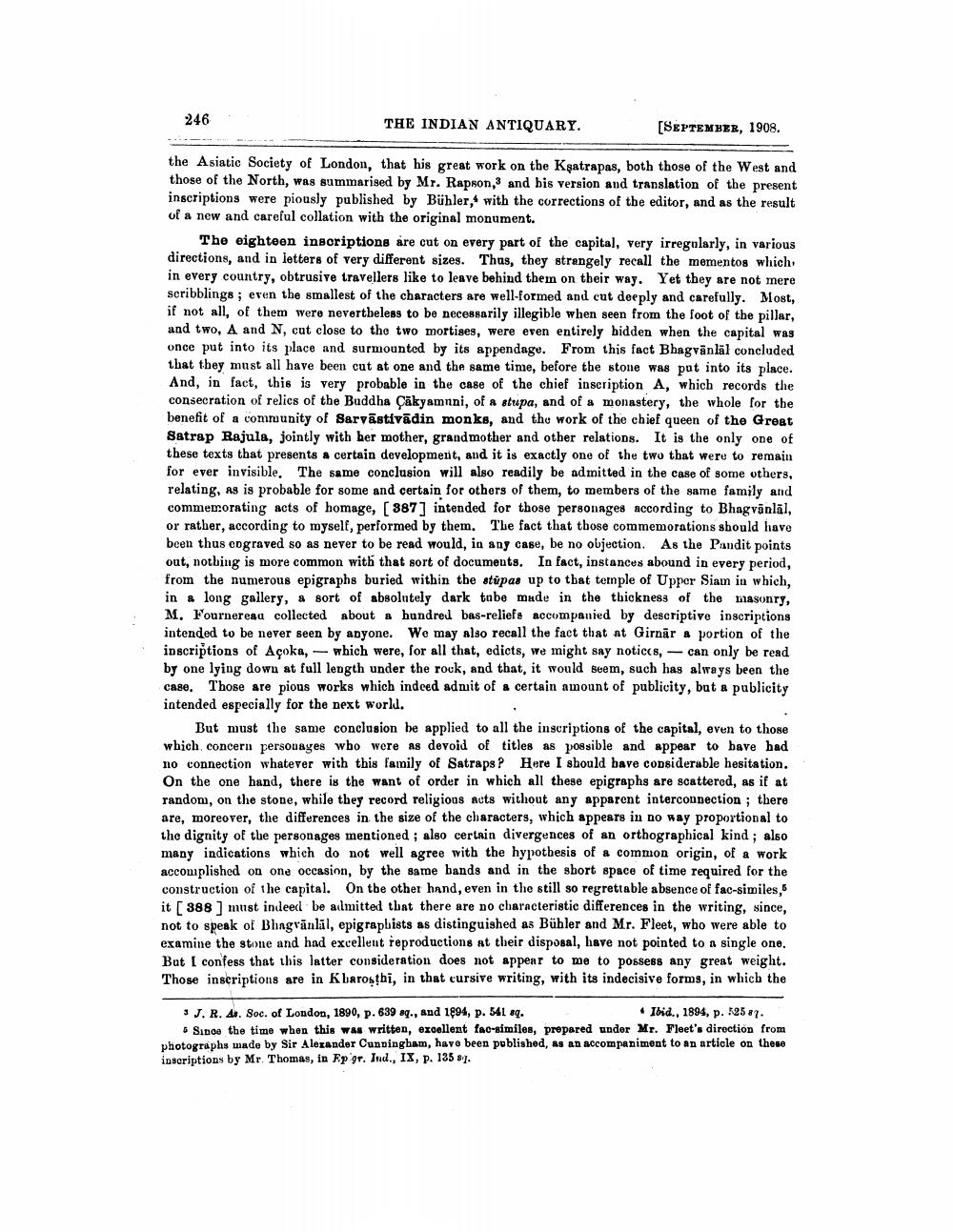________________
246
THE INDIAN ANTIQUARY.
[SEPTEMBER, 1908.
the Asiatic Society of London, that his great work on the Ksatrapas, both those of the West and those of the North, was summarised by Mr. Rapson, and his version and translation of the present inscriptions were piously published by Bühler, with the corrections of the editor, and as the result of a new and careful collation with the original monument.
The eighteen inscriptions are cut on every part of the capital, very irregularly, in various directions, and in letters of very different sizes. Thus, they strangely recall the momentos which in every country, obtrusive travellers like to leave behind them on their way. Yet they are not mere scribblings; even the smallest of the characters are well-formed and cut deeply and carefully. Most, if not all, of them were nevertheless to be necessarily illegible when seen from the foot of the pillar, and two, A and N, cut close to the two mortises, were even entirely hidden when the capital was once put into its place and surmounted by its appendage. From this fact Bhagvānläl concluded that they must all have been cut at one and the same time, before the stone was put into its place. And, in fact, this is very probable in the case of the chief inscription A, which records the consecration of relics of the Buddha Çākyamnni, of a stupa, and of a monastery, the whole for the benefit of a community of Sarvāstivādin monks, and the work of the chief queen of the Great Satrap Rajula, jointly with her mother, grandmother and other relations. It is the only one of these texts that presents a certain development, and it is exactly one of the two that were to remain for ever invisible. The same conclusion will also readily be admitted in the case of some others, relating, As is probable for some and certain for others of them, to members of the same family and commemorating acts of homage, [387] intended for those personages according to Bhagvanlal, or rather, according to myself, performed by them. The fact that those commemorations should have been thus engraved so as never to be read would, in any case, be no objection. As the Pandit points out, notbing is more common with that sort of documents. In fact, instances abound in every period, from the numerous epigraphs buried within the stūpas up to that temple of Upper Siam in which, in a long gallery, a sort of absolutely dark tabe made in the thickness of the masonry, M. Fournereau collected about a hundred bas-reliefs accompanied by descriptive inscriptions intended to be never seen by anyone. We may also recall the fact that at Gimnār a portion of the inscriptions of Açoka, - which were, for all that, edicts, we might say notices, - can only be read by one lying down at full length under the rock, and that, it would seem, such has always been the case. Those are pious works which indeed admit of a certain amount of publicity, but a publicity intended especially for the next world.
But must the same conclusion be applied to all the inscriptions of the capital, even to those which concern personages who were as devoid of titles as possible and appear to bave had no connection whatever with this family of Satraps? Here I should have considerable hesitation. On the one hand, there is the want of order in which all these epigraphs are scattered, as if at random, on the stone, while they record religious acts without any apparent interconnection ; there are, moreover, the differences in the size of the characters, which appears in no way proportional to the dignity of the personages mentioned ; also certain divergences of an orthographical kind; also many indications which do not well agree with the hypothesis of a common origin, of a work accomplished on one occasion, by the same bands and in the short space of time required for the construction of the capital. On the other hand, even in the still so regrettable absence of fac-similes, it [388] must indeed be aclmitted that there are no characteristic differences in the writing, since, not to speak of Blingvänlül, epigraphists as distinguished as Bühler and Mr. Fleet, who were able to examine the stone and had excellent reproductions at their disposal, have not pointed to a single one. Bat I confess that this latter consideration does not appear to me to possess any great weight. Those inscriptions are in Klarostbi, in that cursive writing, with its indecisive forms, in which the
3 J. R. As. Soc. of London, 1890, p. 639 sq., and 1994, p. 541 sq.
• Ibid., 1894, p. 2587. 5 Since the time when this was written, excellent fac-similes, prepared under Mr. Fleet's diroction from photographs made by Sir Alexander Cunningham, have been published, as an accompaniment to an article on these inscriptions by Mr. Thomas, in Ep 9r. Ind., IX, p. 135 8.




